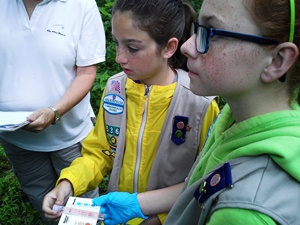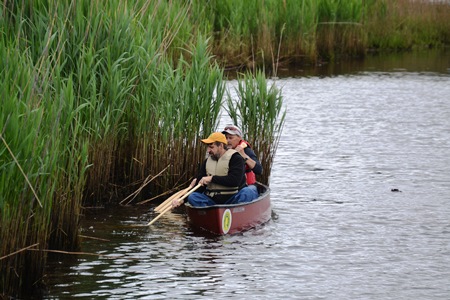National Goals
As we work together to reach our
Clean Water Challenge goals, the national organization will proactively support chapters, members, and other volunteer groups. We are committed to achieving specific results by the 2018 national convention to ensure the successful launch of the Challenge. Over the next 12 months, the national organization will focus specifically on press outreach, building partnerships, supporting volunteers locally, using social media channels to promote the Challenge, and connecting with chapters to share results.
Press Outreach
The national organization is implementing an aggressive communications strategy using
Stream Selfies, volunteer monitoring data, and other local results to promote the Clean Water Challenge to media outlets, policymakers, and communities nationwide.
To engage the media, we need information from chapters and partners about how many citizens are monitoring streams, monitoring results (whether water quality is good or bad), and compelling stories about why these streams matter locally. Results and local stories are the essential raw materials of a successful media campaign – and we need our members and chapters to provide that information. Then it’s our job to use it.
National Partnerships
League staff are working to foster partnerships with other national organizations that can help grow the League’s volunteer base nationwide.
 Girl Scouts of the USA:
Girl Scouts of the USA: As part of a nationwide initiative to promote citizen science, the Girl Scouts national organization selected the League’s Stream Selfie as one of seven projects it is promoting to 1.9 million Girl Scouts across the country. In an
introductory video designed for Girl Scouts, League staff highlight how this project can help Scouts discover local waters, connect with others who care about clean water, and take action to improve water quality in their communities. Every Girl Scout who contributes to the Stream Selfie project is encouraged to take follow-up steps to improve water quality locally, including organizing stream clean-ups and volunteer stream monitoring teams, so this is a good jumping off point for engaging Girl Scouts in additional clean water efforts.
Boy Scouts of America: The League put the Clean Water Challenge in front of thousands of Boy Scouts and their parents and leaders at the Boy Scouts of America National Jamboree in July. The 2,500 Scouts who visited our exhibit on the Conservation Trail took home information about Stream Selfies, our
Aqua Bugs app for identifying macroinvertebrates, and how to get involved in stream monitoring in their communities. League staff also provided a handout to Scout leaders that matched up stream monitoring with specific Boy Scout merit badge and award requirements, providing further incentive for Scouts to get involved. Chapters working with Scouting units can start with Stream Selfie to engage Scouts in water-based projects at the chapter and in the community.
Waterkeeper Alliance: The League is working with the Waterkeeper Alliance to provide training and support to the more than 190 Riverkeeper organizations dedicated to protecting local waterways. League staff attended the international Waterkeeper Alliance annual meeting earlier this year to highlight the Clean Water Challenge. Starting this fall, League staff will be training hundreds of volunteers and dozens of Riverkeeper staff across the country on Save Our Streams to continue expanding the volunteer monitoring network from coast to coast.
Hands-On Training and Support
The League added new staff capacity to support members and chapters with stream monitoring training and other efforts. So far this year, staff traveled to nearly 20 states, from New York to California and places in-between – including Iowa, Utah, West Virginia, and Florida – to promote the Clean Water Challenge, train volunteer stream monitors, and raise the visibility of the League in the conservation community. Through our train-the-trainer program, staff are expanding our network of certified trainers to help the League reach more volunteers and citizen scientists.
League staff can travel to your community to train and support stream monitors and help chapters build partnerships with other organizations to engage new volunteers. Training workshops are scheduled this fall in Maryland, Pennsylvania, and Virginia. Visit our website for
information on upcoming trainings or to request a workshop in your community.
Social Connections

The League continues to use a range of social media channels to reach out to members, supporters, and other people interested in conservation and outdoor recreation. In 2017, we are using Stream Selfie to test the effects of “boosting” Facebook posts to reach a larger audience beyond the 4,700 people currently following the League on Facebook.
The results to date are promising. A boosted Facebook post in April reached more than 26,000 people (compared with a daily average of 2,451) and 779 people engaged with the content (clicked, commented, liked). In June, a boosted post reached 17,150 people and engaged 576 people. Staff will continue to explore this and other ways to cost-effectively raise the League’s visibility through social media channels.
Selfie Connections
Stream Selfies can link the League with thousands of potential volunteers across the country who care about clean water. As more Selfies are added to the League map, staff will connect Selfie takers interested in volunteering further with League chapters and partner organizations that have joined the Clean Water Challenge. (This will be restricted to participants who opted in to receive information from the League.) In addition, chapters can share local Selfies on social media to help recruit volunteers and raise awareness of water quality issues.
Success Stories
The most compelling stream monitoring stories are about volunteers – why they first got involved, what they found through stream monitoring, and how they helped solve local pollution problems. League staff will be reaching out to members, partners, and other community volunteers to find these stories and use them to engage new volunteers in the Clean Water Challenge and promote the Challenge to the media. Please share your success stories with us, from forming new partnerships and engaging new volunteers to working with local government agencies to identify and solve water quality problems. E-mail
sos@iwla.org and League staff will contact you for more details.
These are just some of the actions we’ll take in year one to engage more Americans in the Clean Water Challenge. Together, we can monitor more streams and improve water quality across America. Let’s get started!